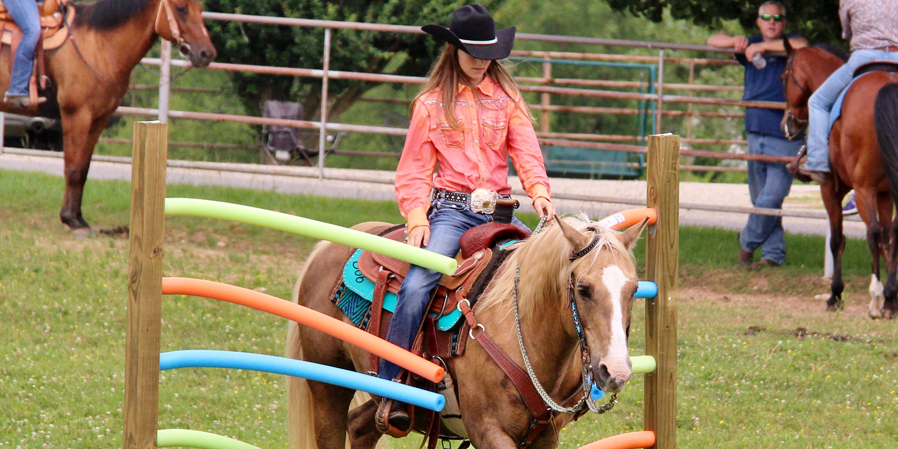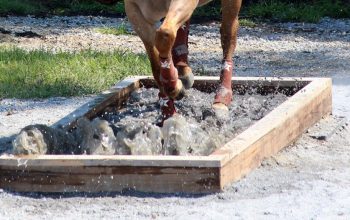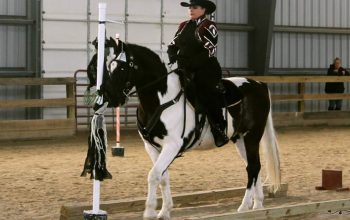By Meg Wills-O’Daniel
 AHCA; what is it you ask? I have heard and read many such questions since it’s founding in December of 2011. The way I describe it to new people is like this: imagine using a horse on a real working ranch and the things you might encounter such as: ditches, hills, bridges, water, brush, cows, gates, etc. You may have to pull brush off a fence, jump a log, carry an injured calf back to the barn, shoot a snake, rope or cut off a calf, cross a creek, or lead a horse home. It may be raining, hot, cold, with varied terrain. Then imagine all of the competitive events that are part of the equine world: barrel racing, pole bending, hunter over fences, roping, working cow horse, cutting, reining, dressage, trail riding, trail class, mounted shooting, any pleasure division, and the list can go on. AHCA takes aspects from as many as 13 different disciplines and will combine them into a course of up to 13 obstacles, depending on the division. This is truly a great way to challenge each horse and rider team. The courses are designed to help the horses and riders succeed, not fail. By doing this, it allows growth as riders, trainers and well-rounded horses. Another unique aspect of the American Horsemen Challenge Association is that it is open to any breed of horse, pony, mule or donkey including those that gait.
AHCA; what is it you ask? I have heard and read many such questions since it’s founding in December of 2011. The way I describe it to new people is like this: imagine using a horse on a real working ranch and the things you might encounter such as: ditches, hills, bridges, water, brush, cows, gates, etc. You may have to pull brush off a fence, jump a log, carry an injured calf back to the barn, shoot a snake, rope or cut off a calf, cross a creek, or lead a horse home. It may be raining, hot, cold, with varied terrain. Then imagine all of the competitive events that are part of the equine world: barrel racing, pole bending, hunter over fences, roping, working cow horse, cutting, reining, dressage, trail riding, trail class, mounted shooting, any pleasure division, and the list can go on. AHCA takes aspects from as many as 13 different disciplines and will combine them into a course of up to 13 obstacles, depending on the division. This is truly a great way to challenge each horse and rider team. The courses are designed to help the horses and riders succeed, not fail. By doing this, it allows growth as riders, trainers and well-rounded horses. Another unique aspect of the American Horsemen Challenge Association is that it is open to any breed of horse, pony, mule or donkey including those that gait.
I have never done anything like this and my horse is inexperienced?
There is a division for all riders and horses, no matter what level you happen to be. The Wrangler division is for riders 12 and under, while the Youth division goes up to 18. There is an English division as well as Novice, Amateur, Legends (those over 55), and the Open division. In 2014 the Green Horse, open to any age horse in their first year competing on obstacles under saddle, and an In-Hand division, any age horse or handler, were added. I have yet to meet any member who is not willing to help any and all of the competitors. We will even call out the pattern for you, if you need help remembering it. All affiliates holding AHCA sanctioned events are required to pay back 50% of the entry fees in money or prizes in the case of the Wrangler & Novice divisions.
What are the judges looking for?
First of all, they want to see a nice team completing obstacles to the best of that particular teams ability. In other words, they would like to see good horsemanship: smooth transitions, correct leads, bending properly and round circles. Slower with proper technique is better than faster and sloppy. Horsemanship and Safety are of the utmost importance. Ultimately, speed with proper technique is the final goal. Keep in mind this takes practice, patience, and time. Most horses and riders will not start here, but all of them can end up here.
What if I ride a gaited horse?
All of the AHCA judges are required to pass a written test with a 90%. This test has several questions pertaining to gaited horses as well as English horses. They strive to have judges that are well rounded in a variety of equine disciplines and breeds.
 Another aspect that is unique to AHCA and I feel is a huge draw to exhibitors, spectators, and judges is the riders’ ability to show off their horses’ talents in addition to completing the designated obstacles. For example, a rider may want to add flying lead changes on the way to another obstacle or throw in a sliding stop with a sidepass or rollback. Perhaps they are riding a great jumper and they find a way to show off this talent in addition to the required obstacles, provided they clear it with the judge first. Yes there is an English Division as well.
Another aspect that is unique to AHCA and I feel is a huge draw to exhibitors, spectators, and judges is the riders’ ability to show off their horses’ talents in addition to completing the designated obstacles. For example, a rider may want to add flying lead changes on the way to another obstacle or throw in a sliding stop with a sidepass or rollback. Perhaps they are riding a great jumper and they find a way to show off this talent in addition to the required obstacles, provided they clear it with the judge first. Yes there is an English Division as well.
After having the opportunity to ride at the AHCA National Finals the last 2 years, I thought I would write my reflections on my experience during the finals. First, I will mention that my thoughts come from not only a competitor’s view, but that of a judge and trainer of several different breeds and a variety of disciplines.
During Saturday afternoon while the AHCA crew was busy setting the course for the final go, I remember watching some of the obstacles being set and remember thinking “I have no idea what Squeeky will think of this”. Some of the obstacles that fell into ‘this’ were as follows: guineas, a turkey, mechanical cow, a bridge with pop up flags/ribbons, and cavelletti type boxes (on top of a multi colored tarp) containing balls leading to a bridge with balls on the rails. I heard several comment on the reasons & safety of some of these obstacles and while I had no idea what my mare was going to think or do (and my first trip was in an English saddle…gulp); I did however, have complete faith in Jeff Lebbin as a horsemen and the course designer to have obstacles that were new, challenging, and most importantly safe.
 I finally got my opportunity to ride the final course in the English division on Saturday and the Open course on Sunday. Ahead of the ride, I planned how to get by the guineas and figured I would turn her head away and use my leg to push her laterally around, if it became necessary. When I got in next to them, she really didn’t care too much. The turkey was not a problem for her (or very many horses, that I watched). I felt the mechanical cow was a great obstacle to show off doubling or show that rollbacks were really being done. I even watched one horse and rider do a great job of using the cow as a cutting horse would. One of the most talked about obstacles had to have been the bridge with the pop up ribbons. I pointed my mare and asked her to cross. After a brief hesitation, she went right on across. When the ribbons popped up on the side, I want to clarify that they did not come anywhere close to touching the horse nor were they close to her face. She startled slightly and she was watching a little more for a couple of obstacles. Later, I was talking with a mom of a youth rider and she told her daughter, “If Squeeky can do it anyone can”. For those not familiar with this mare, she has a tendency to be rather reactive. They removed the balls from the cavelletti boxes (they were only going to be on the side of the bridge, but were completely removed), but the multi colored tarp was a challenge for several horses. There was a slant bridge that most horses did without too much problem. My comment to the other English riders when I finished that course was “That was a fun course. You’re going to love it.”
I finally got my opportunity to ride the final course in the English division on Saturday and the Open course on Sunday. Ahead of the ride, I planned how to get by the guineas and figured I would turn her head away and use my leg to push her laterally around, if it became necessary. When I got in next to them, she really didn’t care too much. The turkey was not a problem for her (or very many horses, that I watched). I felt the mechanical cow was a great obstacle to show off doubling or show that rollbacks were really being done. I even watched one horse and rider do a great job of using the cow as a cutting horse would. One of the most talked about obstacles had to have been the bridge with the pop up ribbons. I pointed my mare and asked her to cross. After a brief hesitation, she went right on across. When the ribbons popped up on the side, I want to clarify that they did not come anywhere close to touching the horse nor were they close to her face. She startled slightly and she was watching a little more for a couple of obstacles. Later, I was talking with a mom of a youth rider and she told her daughter, “If Squeeky can do it anyone can”. For those not familiar with this mare, she has a tendency to be rather reactive. They removed the balls from the cavelletti boxes (they were only going to be on the side of the bridge, but were completely removed), but the multi colored tarp was a challenge for several horses. There was a slant bridge that most horses did without too much problem. My comment to the other English riders when I finished that course was “That was a fun course. You’re going to love it.”
Some of the newer obstacles simulated walking on the side of a hill, working around various animals, going down a trail or across a field and stepping on or hitting a branch that swings up at either your horse or the horse behind you. All of this has happened to a horse and me at one time during the many miles I have ridden out in this great country of ours. I feel one of the great things about AHCA is the variety of circumstances we use in each one of our courses. I do want to mention that if there is an obstacle you feel that you and/or your horse are not ready for, you will not be disqualified for going around it.
 I can imagine that the judging of these courses was both fun and rewarding. We all pull for each other and the judges are pulling for every team as well. It allowed them to see us in a variety of circumstances and not just did our horse ‘do it’, but how did we as riders handle their reaction. I imagine they could see trust as well as training, teamwork and well thought out rides. Having judged at our National Final level in the past, I know that those rides are thrilling to watch.
I can imagine that the judging of these courses was both fun and rewarding. We all pull for each other and the judges are pulling for every team as well. It allowed them to see us in a variety of circumstances and not just did our horse ‘do it’, but how did we as riders handle their reaction. I imagine they could see trust as well as training, teamwork and well thought out rides. Having judged at our National Final level in the past, I know that those rides are thrilling to watch.
For more information: www.americanhorsemenchallenge.com
or 810-730-0682
—————————————————————————————————————————–
This article originally appeared in the July Issue of We Ride Sport and Trail Magazine. Click here to see >>




